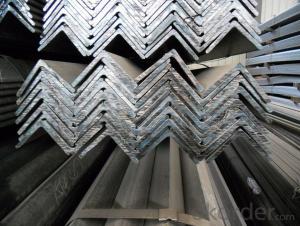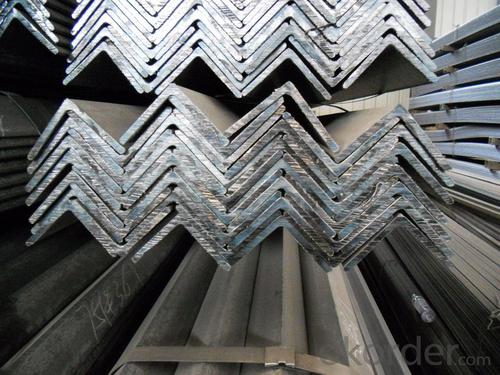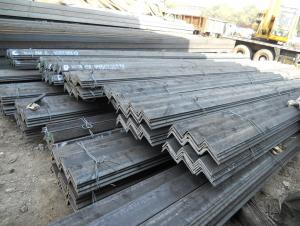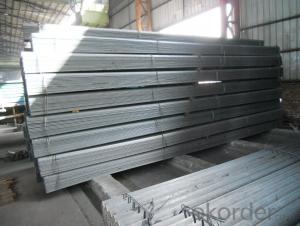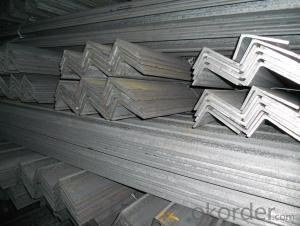Prime Low Carbon Unequal Angle Steel
- Loading Port:
- China main port
- Payment Terms:
- TT OR LC
- Min Order Qty:
- 100 m.t.
- Supply Capability:
- 20000 m.t./month
OKorder Service Pledge
OKorder Financial Service
You Might Also Like
Product Description:
OKorder is offering Prime Low Carbon Unequal Angle Steel at great prices with worldwide shipping. Our supplier is a world-class manufacturer of steel, with our products utilized the world over. OKorder annually supplies products to African, South American and Asian markets. We provide quotations within 24 hours of receiving an inquiry and guarantee competitive prices.
Product Applications:
Prime Low Carbon Unequal Angle Steel are ideal for structural applications and are widely used in the construction of buildings and bridges, and the manufacturing, petrochemical, and transportation industries.
Product Advantages:
OKorder's Prime Low Carbon Unequal Angle Steel are durable, strong, and wide variety of sizes.
Main Product Features:
· Premium quality
· Prompt delivery & seaworthy packing (30 days after receiving deposit)
· Can be recycled and reused
· Mill test certification
· Professional Service
· Competitive pricing
Product Specifications:
Manufacture: Hot rolled
Grade: Q195 – 235
Certificates: ISO, SGS, BV, CIQ
Length: 6m – 12m, as per customer request
Packaging: Export packing, nude packing, bundled
| UNEQUAL ANGLE STEEL | |||||
| size(mm) | a(mm) | a1(mm) | thickness(mm) | kg/m | length(m) |
| 75*50*5 | 75 | 50 | 5 | 4.808 | 6m,9m,12m |
| 75*50*6 | 75 | 50 | 6 | 5.699 | 6m,9m,12m |
| 75*50*8 | 75 | 50 | 8 | 7.431 | 6m,9m,12m |
| 100*75*7 | 100 | 75 | 7 | 9.34 | 6m,9m,12m |
| 100*75*8 | 100 | 75 | 8 | 10.6 | 6m,9m,12m |
| 100*75*9 | 100 | 75 | 9 | 11.8 | 6m,9m,12m |
| 100*75*10 | 100 | 75 | 10 | 13 | 6m,9m,12m |
| 100*75*12 | 100 | 75 | 12 | 15.4 | 6m,9m,12m |
| 125*75*7 | 125 | 75 | 7 | 10.7 | 6m,9m,12m |
| 125*75*8 | 125 | 75 | 8 | 12.2 | 6m,9m,12m |
| 125*75*9 | 125 | 75 | 9 | 13.6 | 6m,9m,12m |
| 125*75*10 | 125 | 75 | 10 | 15 | 6m,9m,12m |
| 125*75*12 | 125 | 75 | 12 | 17.8 | 6m,9m,12m |
| 150*90*8 | 150 | 90 | 8 | 14.7 | 6m,9m,12m |
| 150*90*9 | 150 | 90 | 9 | 16.4 | 6m,9m,12m |
| 150*90*10 | 150 | 90 | 10 | 18.2 | 6m,9m,12m |
| 150*90*12 | 150 | 90 | 12 | 21.6 | 6m,9m,12m |
| 200*100*10 | 200 | 100 | 10 | 23 | 6m,9m,12m |
| 200*100*12 | 200 | 100 | 12 | 27.62 | 6m,9m,12m |
| 200*100*15 | 200 | 100 | 15 | 34.04 | 6m,9m,12m |
FAQ:
Q1: Why buy Materials & Equipment from OKorder.com?
A1: All products offered byOKorder.com are carefully selected from China's most reliable manufacturing enterprises. Through its ISO certifications, OKorder.com adheres to the highest standards and a commitment to supply chain safety and customer satisfaction.
Q2: How many tons of steel products could be loaded in containers?
A2: Usually the steel products are delivered by bulk vessel because of the large quantity and the freight. However, there are no bulk vessel enter some seaports so that we have to deliver the cargo by containers. The 6m steel product can be loaded in 20FT container, but the quantity is changed according to the size, usually from 18tons to 25tons.
Q3: what is the difference between actual weight and theoretical weight?
A3: All the section steel has two weights: actual weight and theoretical weight. Actual weight is the weighing out when the product delivered from the mill. Theoretical weight is calculated by pieces. The invoice can be based on each of them as your request.
Images:

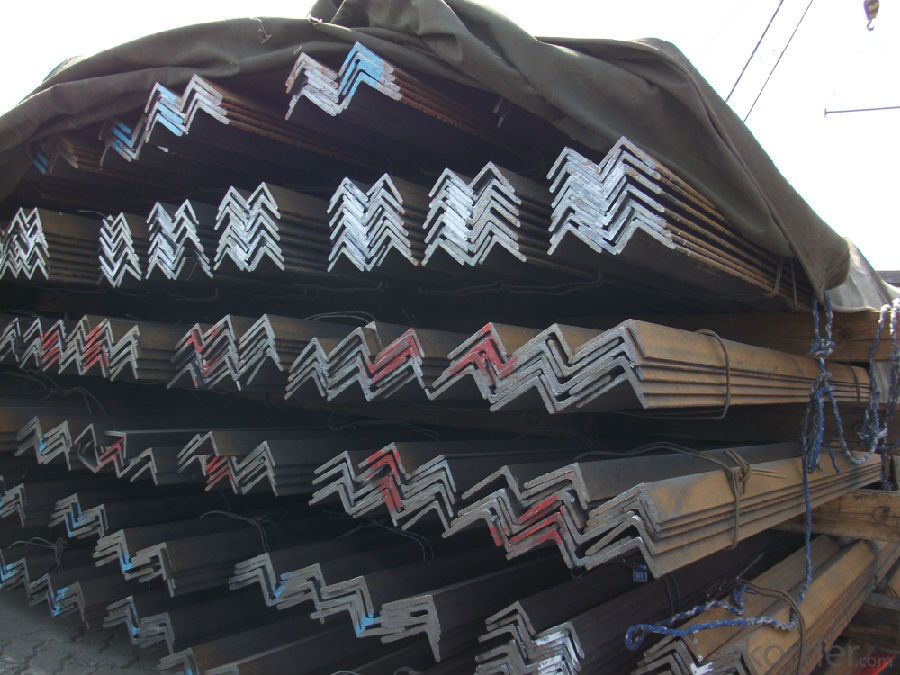
- Q: How do steel angles contribute to the overall stability of a structure?
- Steel angles contribute to the overall stability of a structure by providing additional strength and support. They are often used as structural members in construction projects to connect and reinforce different components, such as beams and columns. The angles help distribute and transfer loads, improving the structure's resistance to bending, buckling, and other forces. Additionally, their L-shape design allows them to resist shear and torsional stresses, enhancing the overall stability and integrity of the structure.
- Q: What is the cost of a steel angle?
- The price of a steel angle may differ based on various factors including its size, grade, thickness, and the supplier or manufacturer chosen. Typically, steel angles are priced either per length or per weight. When determining the cost, it is crucial to take into account the market situation, location, and specific requirements of the desired steel angle. To obtain precise and current pricing details, it is advisable to reach out to local suppliers or manufacturers.
- Q: How can the angle iron tripod be welded or not?
- The angle iron can be made up of different force components according to the different structure, and can also be used as the connecting piece between the components. Widely used in a variety of architectural and engineering structures, such as beams, bridges, towers, hoisting and conveying machinery, ships, industrial furnace, reaction tower, container rack and warehouse shelves.
- Q: How do steel angles perform under cyclic loading?
- Steel angles are widely used in various structural applications due to their excellent strength and stiffness properties. When subjected to cyclic loading, which refers to repeated loading and unloading cycles, steel angles perform exceptionally well. Under cyclic loading, steel angles exhibit a phenomenon known as fatigue, which is the progressive and localized structural damage that occurs when a material is subjected to repeated loading and unloading. However, steel angles have a high fatigue resistance, making them highly suitable for applications where cyclic loading is expected. The key factor contributing to the performance of steel angles under cyclic loading is their material properties. Steel, being a ductile and resilient material, is able to deform and absorb energy under cyclic loading, thereby preventing the accumulation of stress concentrations that could lead to failure. Moreover, steel angles are typically designed with a sufficient factor of safety to withstand cyclic loading without compromising their structural integrity. This ensures that they can endure numerous cycles of loading and unloading without experiencing significant deformation or failure. In addition to their inherent material properties, the structural design and fabrication of steel angles also play a crucial role in their performance under cyclic loading. Proper design, including consideration of the expected loading conditions and appropriate reinforcement, ensures that steel angles can withstand cyclic loading without experiencing excessive deformation or stress concentrations. Overall, steel angles are well-suited for applications involving cyclic loading due to their high fatigue resistance, ductility, and structural design considerations. Their ability to withstand repeated loading and unloading cycles makes them a reliable and durable choice in various structural systems.
- Q: What are the different types of surface finishes available for steel angles?
- Steel angles offer a variety of surface finishes, each with its own unique qualities and advantages. Firstly, there is the mill finish, which is the most basic and commonly used surface finish. It showcases the steel in its raw and untreated state, with potential imperfections and roughness. This finish is typically utilized for structural purposes where aesthetics are not a priority. Another option is hot-dip galvanization, where the steel angle is submerged in molten zinc to create a protective coating against corrosion. This finish is ideal for outdoor or corrosive environments, as it offers high resistance to rust. Powder coating is a popular process in which a dry powder is electrostatically applied to the steel angle and then cured under heat. This results in a durable and visually appealing finish that is highly resistant to chipping, scratching, and fading. Powder coated steel angles are commonly seen in architectural and decorative applications. Painting is another possibility, with various types of paint, such as epoxy, enamel, or acrylic, being applied to the steel angle. This not only enhances the appearance but also provides a protective layer. However, painted surfaces may be more prone to chipping and require regular maintenance. For those seeking a naturally smooth and polished surface, stainless steel angles are an excellent choice. These angles are resistant to corrosion and staining, making them suitable for industries like food processing, pharmaceuticals, and marine environments. Lastly, shot blasting is a surface treatment process that involves bombarding steel angles with small metallic or non-metallic particles at high speed. This effectively removes rust, scale, and contaminants, resulting in a clean and roughened finish. Shot blasting prepares the steel angle for subsequent coating or painting. These examples highlight the diverse range of surface finishes available for steel angles. The choice of finish depends on specific requirements such as corrosion resistance, aesthetics, durability, and cost.
- Q: Are steel angles fire-resistant?
- Yes, steel angles are fire-resistant to a certain extent. Steel is a non-combustible material, meaning it does not burn or contribute fuel to a fire. It has a high melting point, usually around 1370°C (2500°F), which allows it to maintain its structural integrity even under high temperatures. However, it is important to note that while steel itself is fire-resistant, the fire resistance of a structure or component depends on various factors such as the design, size, and configuration of the steel angles, as well as the fire protection measures implemented. Fire protection methods like fire-resistant coatings, fireproofing materials, or fire-resistant insulation can be applied to steel angles to enhance their fire resistance. These additional fire protection measures can provide a certain level of insulation, delaying the transfer of heat to the steel and extending the time it takes for the steel to reach its critical temperature. This allows occupants more time to evacuate the building and firefighters more time to control the fire. In summary, steel angles are inherently fire-resistant due to the properties of steel, but their fire resistance can be further enhanced by implementing appropriate fire protection measures.
- Q: How many meters is one angle steel?
- Standard Specification for hot-rolled equal angle iron is 2#-20#. The angle iron can be made up of different force components according to the different structure, and can also be used as the connecting piece between the components. Widely used in a variety of architectural and engineering structures, such as beams, bridges, towers, hoisting and conveying machinery, ships, industrial furnace, reaction tower, container frame and warehouse.
- Q: What is the typical size range for steel angles?
- The typical size range for steel angles can vary depending on the specific application and industry. However, in general, steel angles are available in a range of sizes that typically fall within the dimensions of 20-200 millimeters (mm) in width and 3-20 mm in thickness. The length of steel angles can vary as well, typically ranging from 3 to 12 meters. These dimensions allow for a versatile range of applications, including structural support in construction, manufacturing of machinery and equipment, and various architectural uses. It's important to note that these size ranges are common, but there may be variations and custom sizes available depending on the specific requirements of a project.
- Q: What are the different types of steel angles connections for mezzanine floors?
- There are several types of steel angle connections commonly used for mezzanine floors, including bolted connections, welded connections, and clip angle connections. Bolted connections involve using bolts and nuts to secure the steel angles together. Welded connections involve welding the steel angles together for a strong and permanent connection. Clip angle connections involve using clips or brackets to connect the steel angles, allowing for easy installation and adjustment. These different types of connections provide flexibility in design and construction of mezzanine floors.
- Q: What are the common methods of joining or connecting steel angles together?
- Common methods of joining or connecting steel angles together include welding, bolting, and using angle brackets or cleats.
Send your message to us
Prime Low Carbon Unequal Angle Steel
- Loading Port:
- China main port
- Payment Terms:
- TT OR LC
- Min Order Qty:
- 100 m.t.
- Supply Capability:
- 20000 m.t./month
OKorder Service Pledge
OKorder Financial Service
Similar products
Hot products
Hot Searches
Related keywords
